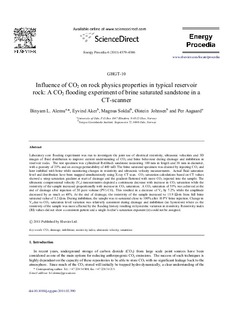Influence of CO2 on rock physics properties in typical reservoir rock: A CO2 flooding experiment of brine saturated sandstone in a CT-scanner
Journal article
Permanent lenke
http://hdl.handle.net/11250/2375290Utgivelsesdato
2011Metadata
Vis full innførselSamlinger
- NGI articles [1061]
Sammendrag
Laboratory core flooding experiment was run to investigate the joint use of electrical resistivity, ultrasonic velocities and 3D images of fluid distribution to improve current understanding of CO2 and brine behaviour during drainage and imbibition in reservoir rocks. The test specimen was cylindrical Rothbach sandstone measuring 100 mm in length and 38 mm in diameter, with a porosity of 23% and an average permeability of 400 mD. The brine saturated specimen was drained by injecting CO2 and later imbibed with brine while monitoring changes in resistivity and ultrasonic velocity measurements. Actual fluid saturation level and distribution have been mapped simultaneously using X-ray CT scan. CO2 saturation calculations based on CT values showed a steep saturation gradient at start of drainage and the gradient flattened with more CO2 injected into the sample. The ultrasonic compressional velocity (V p) measurements depicted a continuous decrease with increase in CO2 saturation while the resistivity of the sample increased proportionally with increase in CO2 saturation. A CO2 saturation of 53% was achieved at the end of drainage after injection of 20 pore volume (PV) CO2. This resulted in a decrease of V pby 7.2% while the amplitude decreased by as much as 48%. At the end of drainage, the resistivity of the sample increased to 13.9 Ω-m from full brine saturated value of 3.2 Ω-m. During imbibition, the sample was re-saturated close to 100% after 10 PV brine injection. Change in V p due to CO2 saturation level variation was relatively consistent during drainage and imbibition (no hysteresis) where as the resistivity of the sample was more affected by the flooding history resulting in hysteretic variation in resistivity. Resistivity index (RI) values did not show a consistent pattern and a single Archie’s saturation exponent (n) could not be assigned.
Beskrivelse
-
